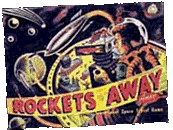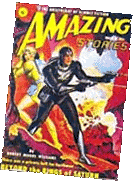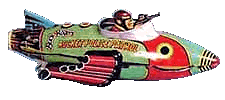
![]()
![]()
![]()
![]()
![]()
The Era Of Buck Rogers And Flash Gordon
Overview
The first toy space guns were produced in the 1930s and 1940s.
Part of the Buck Rogers and Flash Gordon craze that swept the
United States, they were an important byproduct of the popularization
of space that occurred in the early decades of the twentieth century.
During the  1920s and 1930s, an American scientist, Robert H. Goddard, began
the first early tests of liquid-fueled rockets. Disproving the
theory that rockets could not move forward in space because there
was no air to push against, Goddard discovered the basic principles
of rocket science. Yet, ironically, it was not Goddard, the father
of space travel, who first caught the public's attention and popularized
space exploration. It was a far more fanciful and romantic character,
Buck Rogers.
1920s and 1930s, an American scientist, Robert H. Goddard, began
the first early tests of liquid-fueled rockets. Disproving the
theory that rockets could not move forward in space because there
was no air to push against, Goddard discovered the basic principles
of rocket science. Yet, ironically, it was not Goddard, the father
of space travel, who first caught the public's attention and popularized
space exploration. It was a far more fanciful and romantic character,
Buck Rogers.
Anthony "Buck" Rogers was born in August of 1928 in an early edition
of the pulp magazine, Amazing Stories. Although not the first cheap, popular magazine to include tales
of science fiction, Amazing Stories was the first to specialize  in the genre, and its premier editions, published in 1926, contained
reprints of stories by such writers as H.G. Wells and Jules Verne.
Eventually, when it received enough original submissions, the
magazine began to publish new works. And it was in one of these,
in a story entitled "Armageddon 2419" by Philip Nowlan, that Buck
Rogers was created. An air force officer who lapsed into a coma
and awakened in the 25th Century, Rogers and his cohorts, the
lovely Wilma Deering and the intrepid scientist Dr. Huer, struggled
to rid the world of evil warlords and "Mongol" hords.
in the genre, and its premier editions, published in 1926, contained
reprints of stories by such writers as H.G. Wells and Jules Verne.
Eventually, when it received enough original submissions, the
magazine began to publish new works. And it was in one of these,
in a story entitled "Armageddon 2419" by Philip Nowlan, that Buck
Rogers was created. An air force officer who lapsed into a coma
and awakened in the 25th Century, Rogers and his cohorts, the
lovely Wilma Deering and the intrepid scientist Dr. Huer, struggled
to rid the world of evil warlords and "Mongol" hords.
The editors of the National Newspaper Service were looking for a new adventure comic strip, and so in January of 1929 Philip Nolan and illustrator Dick Calkins were invited to inaugurate a syndicated comic strip of Buck's adventures which became so popular that it ran for over forty years. A radio adaptation was broadcast from 1932 to 1947, movies were made, and television versions ran in the 1950s and 1980s. Buck Rogers became THE American space hero, and one of the great American heroes of all time. So insatiable was the public appetite for the daring space traveler that he spawned another popular space hero, Flash Gordon, created in 1934 by King Features to compete with the Buck Rogers comic strip. Like Buck, Flash soon became a comic book hero and radio star, and over the years, he appeared in the movies and on television. By the end of the 1930s, space had become a popular and well-known adventure setting. And until the late 1950s and early 1960s, with the inauguration of the space race, Buck Rogers and Flash Gordon were probably responsible for teaching most Americans what they knew about outer space.
Ray Guns of the 1930s and 1940s
Space guns were just one of the many kinds of space toys and memorabilia
that accompanied and promoted the popular interest in space during
the 1930s and 1940s. From storybooks to space helmets and games
to model rocketships, space-related merchandise captured the American
consumer's imagination. This was not surprising. For by the 1930s,
the practice of promoting toys and other saleable goods by connecting
them to popular comic strip characters and radio personalities
was well established. The Yellow Kid, America's  first well known comic newspaper character in the late 19th century,
established a kind of precedent when he became the subject of
numerous licensed products sold to cash in on his popularity.
With the advent of radio this practice intensified as advertisers
rushed to associate themselves with popular radio characters by
producing and distributing products, or "premiums," connected
to these characters. Buck Rogers was one of the most often licensed
characters, as companies like Kellogg's, Cream of Wheat and Onward
School Supplies promoted their products by offering Buck Rogers
merchandise. The first toy space gun was created exclusively as
a premium, and other early guns, particularly some made by Daisy,
were sold both in stores and offered as product promotions. In
all, over three million Buck Rogers guns were sold by Daisy by
the end of the 1940s.
first well known comic newspaper character in the late 19th century,
established a kind of precedent when he became the subject of
numerous licensed products sold to cash in on his popularity.
With the advent of radio this practice intensified as advertisers
rushed to associate themselves with popular radio characters by
producing and distributing products, or "premiums," connected
to these characters. Buck Rogers was one of the most often licensed
characters, as companies like Kellogg's, Cream of Wheat and Onward
School Supplies promoted their products by offering Buck Rogers
merchandise. The first toy space gun was created exclusively as
a premium, and other early guns, particularly some made by Daisy,
were sold both in stores and offered as product promotions. In
all, over three million Buck Rogers guns were sold by Daisy by
the end of the 1940s.
![]()
![]()
![]()
 |
BUCK ROGERS DISTINTEGRATOR PISTOL This Art Deco "tour-de-force," called the XZ-38, is one of the first toy ray guns ever made. Produced by Daisy around 1935, it sports a fluted barrel, bristling flamboyant fins, and an "electronic compression chamber" which sparks menacingly when the trigger is pulled. The Disintegrator Pistol is one of the classics which first established the conventions on which toy ray guns would be modeled. |
 |
ATOM-MATIC WATER ROCKET GUN This water pistol, made by the Playcraft Company of Skokie, Illinois, in the late 1940s, is an aesthetic and technological marvel of the time. One of the first toy guns made from aluminum or plastic, it features a stark, minimalist design resembling some modern sculpture of the period. In this design, the narrow barrel visually recedes from the rectiliniar handle and three discs at the barrel tip, creating the illusion of floating, geometric shapes. |
 |
SPINRAY BLAST PISTOL The Spinray was made by Armstrong and Brewer of Kalamazoo, Michigan, around 1948, and is among the most unusually shaped toy guns ever manufactured. Made of cast aluminum, it has a strong techno-industrial appearance, which contrasts dramatically with the delicate propellor and flower-shaped design on the gun body. |
